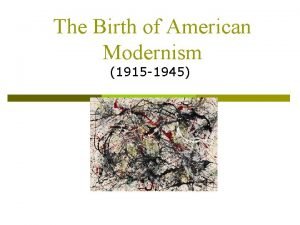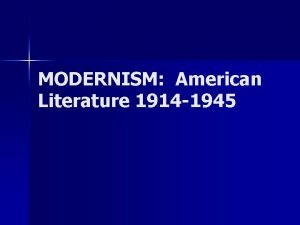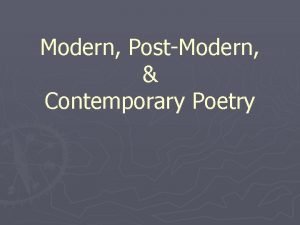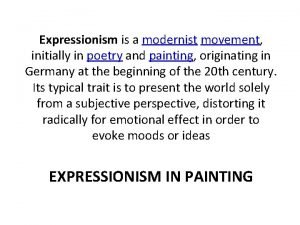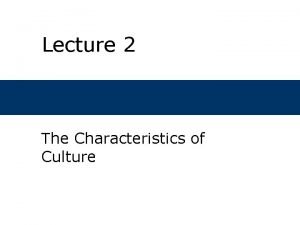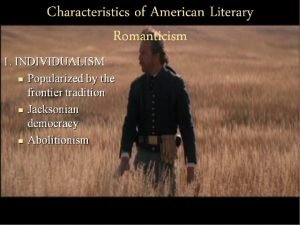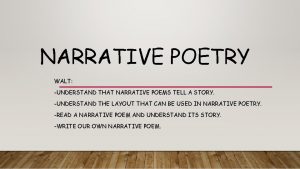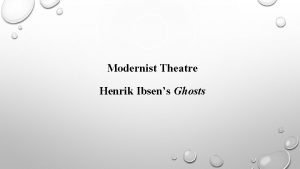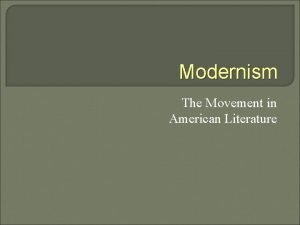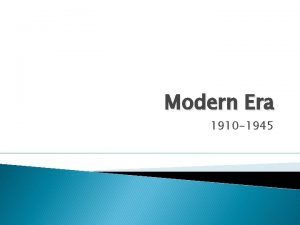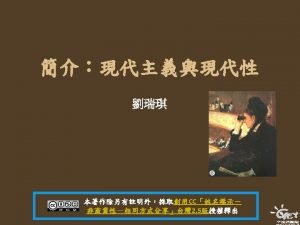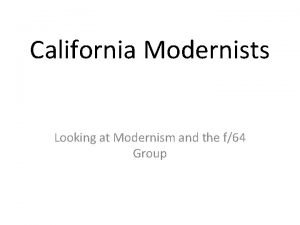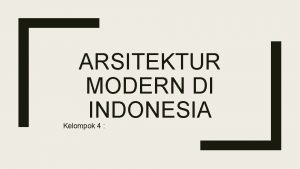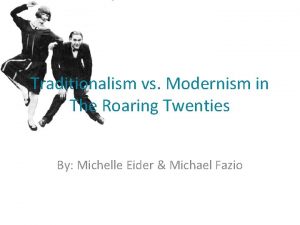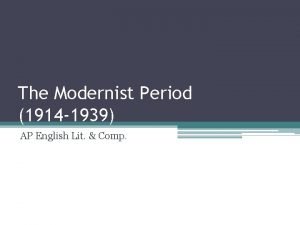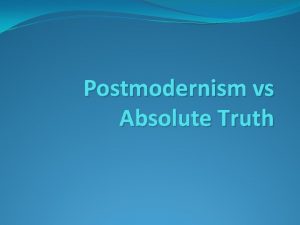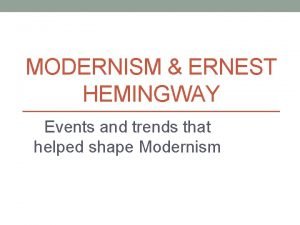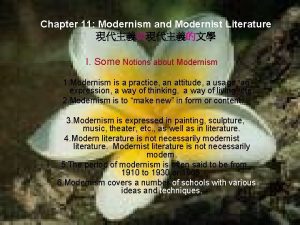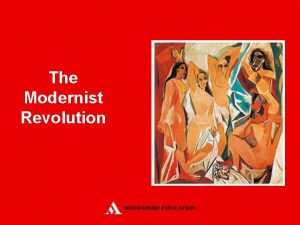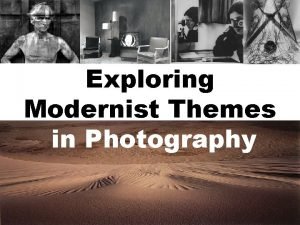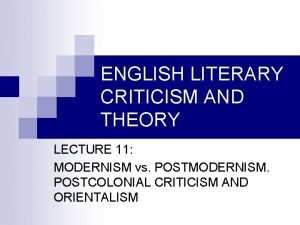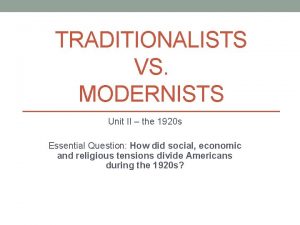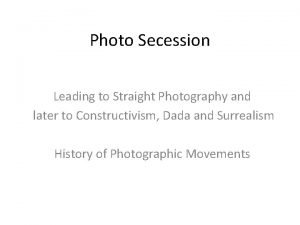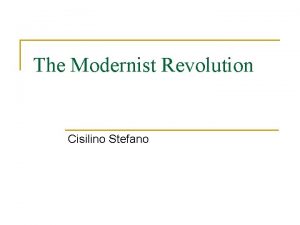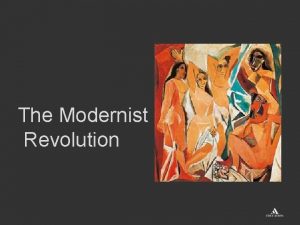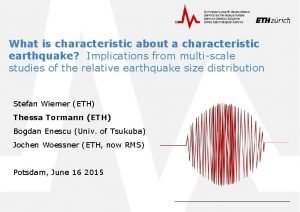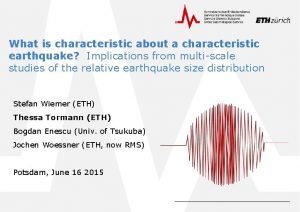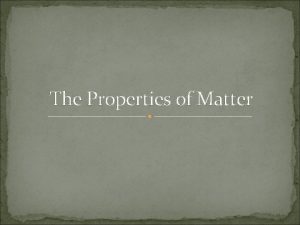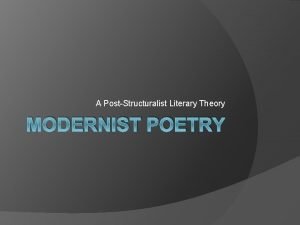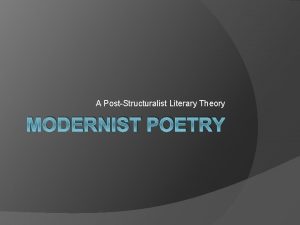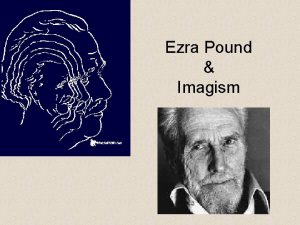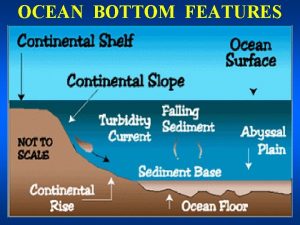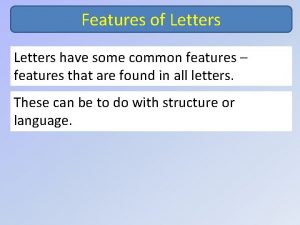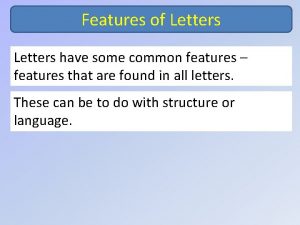AMERICAN MODERNIST POETRY Characteristic Features of Modernist Poetry


























- Slides: 26

AMERICAN MODERNIST POETRY

Characteristic Features of Modernist Poetry • The shift of emphasis on the selfreferentiality of poetic language based on the very modern notion of a crisis of language; • A search for the overall coherence of language as the preeminent cultural system; • The increasing doubt about the possibility of identifying a single, unified speaking subject as the voice in modernist poerty.

The Great Variety of American Modernist Poetry • The dadaist and surrealist poems of Gertrude Stein • The Imagist poems of Ezra Pound, H. D. (Hilda Doolittle) and Amy Lowell • T. S. Eliot’s The Waste Land

H. D. in the mid 1910 s Ezra Pound in 1913.

The Great Variety of American Modernist Poetry • Vachel Lindsay’s doomed fantasy of a fully public, participatory, democratic poetry; • The restrained and universalizing regional poems of William Carlos Williams; • The prolific Black poetry of Langston Hughes and the other blues writers of the Harlem Renaissance.

The Great Variety of American Modernist Poetry • The populist poems celebrating American life (Little Red Song Book, 1909, IWW, Joe Hill) • The socially and politically engaged poetry that appeared and continued to develop especially throughout the late 20 s

Modernist Poetic Landmarks • Alfred Stieglitz’s Camera Work Magazine: • Gertrude Stein’s essays • Mina Loy’s “Aphorisms on Futurism”

Harriet Monroe’s Poetry

Gertrude Stein 1874“The Mother of Us All” (1946) • Studied with William James at Radcliffe College • Studied brain anatomy at Johns Hopkins Medical School • Major preoccupations: • characterization • the reader’s preoccupation with the text.

Expatriation • In 1903 moved to France • Met Alice B. Toklas • Returned to the United States only once, in 1934 but claimed America as her country • Her career in Europe was that of an art critic • Paul Cezanne was discovered by her brother • She was called “the Mama of Dada” • Pablo Picasso drew her portrait

Writings • Three Lives, written in 1904, published in 1909 • The Making of Americans, written in 191112, published in 1925 • Tender Buttons (1914) • Tender Buttons Two: Gertrude Stein and her Brother and G. M. P. • The Autobiography of Alice B. Toklas (1933)

Writings • The Geographical History of America (1935) • Picasso (1938) • The Mother of Us All (1946). • Bee Time Vine and Other Pieces (1953) • Stanzas in Meditation and Other Poems (1956).

• Features of Stein’s Works An attempt to achieve a kind of verbal “after -image” that would penetrate the reader’s consciousness and evoke some genuine response • Subversion of familiar literary techniques, using deliberately unliterary language and diction and writing in unliterary structures • Insisted that writing should be about real characters, real objects, real scenes from American life forcing the reader to complete the description.

Features of Stein’s Works • Draws emotional states but not their physical presence creating the most not visual characteristics of the objects and avoiding labels (Tender Buttons) • Wit and experimentation • Use of “disguising” tactics • Characters’ motivations are purely emotional and unchangeable.

Features of Stein’s Works • Her work still defies any genre-oriented classifications as well as any attempts to assign a humanizing persona to the poetic voice • Devoted to an exploration of how language works, anticipated not only most of the linguistic experimental strain of modernism but much of postmodernism as well.

Ezra Pound 1885 -1972 • Family background • Education: University of Pennsylvania, met William Carlos Williams, transferred to Hamilton College • Expatriation: 1908 settled in London, a productive friendship with William Butler Yeats. His poetry from the years 1908 -1914 reflects his struggle to achieve clarity, precision, and a direct conversational diction.

Writings • Personae (1909), to be revised and re-issued in 1926 as Personae: The Collected Poems. • Patria Mia (1912), essays on American literature and society • Indiscretions (1920), autobiographical writing

Poetic Philosophy • The modern poet can recapture the vitality of ancient myths. • The notion of personae, or masks: the contemporary poet can sustain a dialogue between past and present by speaking through various historical personalities. • Pound’s obsession with the literary past, his desire to revive ancient ghosts: “The Spirit of Romance” (1910) anticipates T. S. Eliot’s argument in “Tradition and the Individual Talent” (1919)

Poetic Dictum • The language in his first poems - obscure and antiquated. Ford M. Ford: all poetry should have the economy and precision of prose • The concept of translation as a dynamic act-“I gather the Limbs of Osiris” (1911 -12), a translation of the Anglo-Saxon poem Seafarer. • Criticism and poetic activity are inseparable. • Five kinds of fusion between poetry and criticism

The Poet-Critic • Criticism by discussion. • Criticism by translation: Cathay (1915) and Umbra (1920). • Criticism by exercise in the style of a given period • Criticism via music and the importance of “melopoeia’ • The highest form is criticism in new composition.

Imagism and Vorticism • Started around 1912; the first Imagist anthology, Des Imagiste (1914). • Based on the ideas of Hulme, Pound’s imagism soon turned the doctrine, which was heavily indebted to the Symbolist. Impressionist way of thinking into an anti. Symbolist and anti-Impressionist platform.

The Image • A “direct treatment of the “thing” whether subjective or objective”. • No words that do not contribute to the presentation. • “To compose in sequence of the music phrase, not in sequence of a metronome”. • The Image is a fusion of spontaneity, intensity and critical discipline, it is also an ‘equation’ for an emotion, it’s not the verbal metaphor of a ‘thing’.

Vorticism • Collaboration with the Vorticists • Strengthened his conviction that the ‘permanent’ or ‘absolute’ image-complex juxtaposition must be active rather than static • Vorticist images “swirl, whirl, flutter, strike, fall, move, clash and leap, with a new emphasis on conflict and distortion” • A re-definition of the Image as Vortex

Image/Vortex • “The image is not an idea. It is a radiant node or cluster; it is what I can, and must perforce, call a VORTEX, from which, and through which, and into which ideas are constantly rushing. ” Thus the image can be described as content conceived of as form. It provides a medium for exploration, rather than a territory to be explored. It is, in his own words, a new focus.

Hugh Selwyn Mauberley • Hugh Selwyn Mauberley in 1920, as a farewell to London. This was a poem meant to emphasize the plight of the Odyssean artist in the modern world • The second part of the poem is a comment on the first and the prevailing atmosphere is one of postwar disillusionment.

The Cantos • Moved to Italy - a lifetime project, the writing of The Cantos. • A Draft of Thirty Cantos, the first collection, in 1933 • The Fifth Decad of Cantos in 1937 • The Pisan Cantos (74 -84) in 1948 • Rock-Drill (85 -95) in 1955 • Thrones (96 -109) in 1959 • Drafts and Fragments (110 -117) in 1969.
 American modernist novels
American modernist novels Characteristics of modernism in american literature
Characteristics of modernism in american literature 1950
1950 Dr rosa schapire
Dr rosa schapire Characteristic features of culture
Characteristic features of culture Characteristic of american romanticism
Characteristic of american romanticism A poem that tells a story.
A poem that tells a story. Modernism vs postmodernism
Modernism vs postmodernism Ghosts by ibsen summary
Ghosts by ibsen summary Modernism in literature
Modernism in literature The modernist period (1910 to 1945)
The modernist period (1910 to 1945) Clement greenberg modernist painting
Clement greenberg modernist painting Modernism
Modernism Arsitektur pra modern
Arsitektur pra modern Modernism vs traditionalism
Modernism vs traditionalism Modernist literature
Modernist literature Characteristics of modernism
Characteristics of modernism Dirayet tefsirleri
Dirayet tefsirleri Dead american
Dead american What is premodernism
What is premodernism Hemingway modernist
Hemingway modernist Modernist literature characteristics
Modernist literature characteristics Modernist revolution
Modernist revolution Modernist themes
Modernist themes Postmodernism definition
Postmodernism definition Modernism vs traditionalism 1920s
Modernism vs traditionalism 1920s Examples of straight photography
Examples of straight photography
